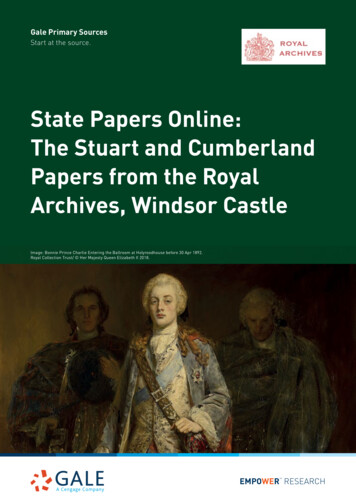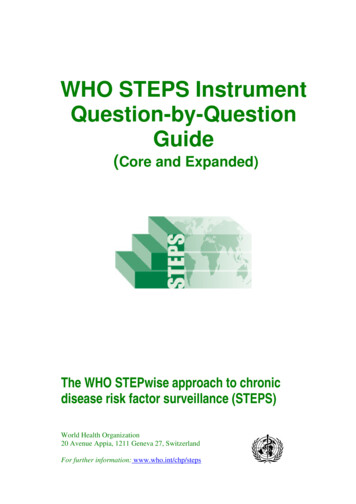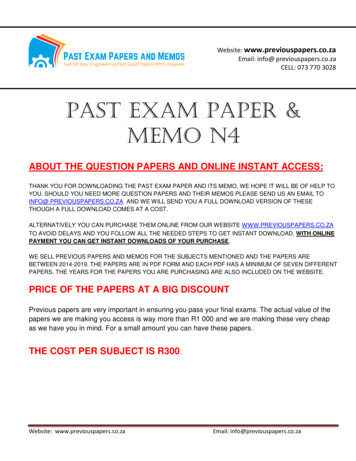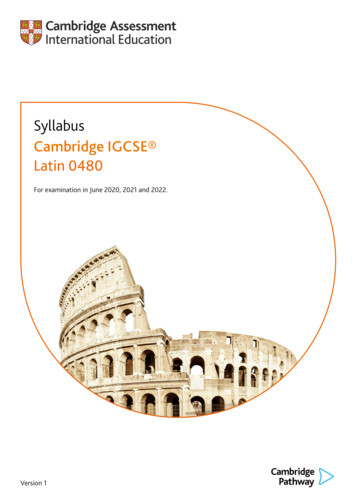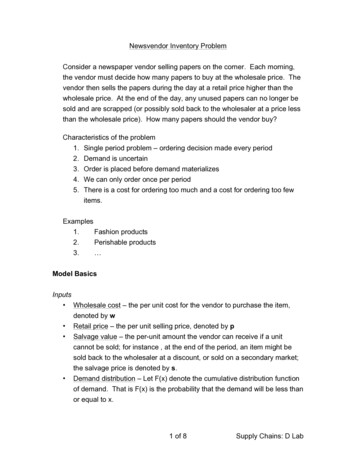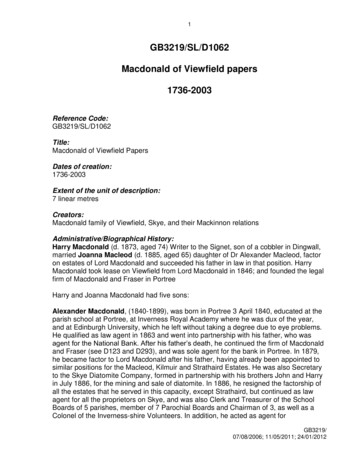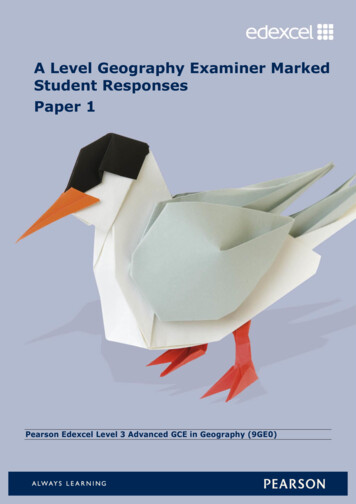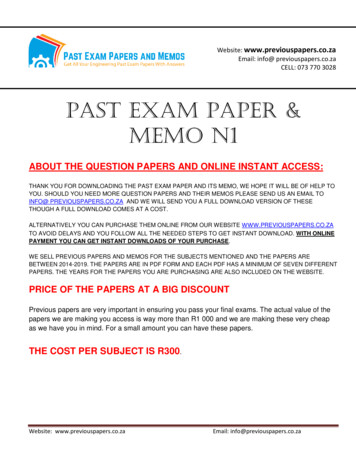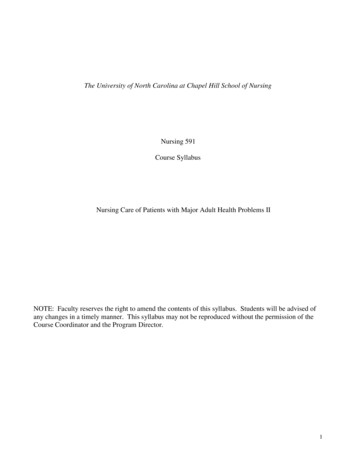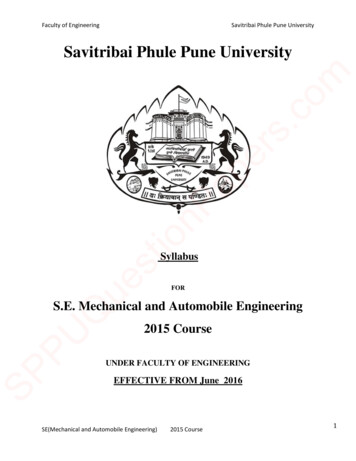
Transcription
Faculty of EngineeringSavitribai Phule Pune UniversitySavitribai Phule Pune UniversitySyllabusFORS.E. Mechanical and Automobile Engineering2015 CourseUNDER FACULTY OF ENGINEERINGEFFECTIVE FROM June 2016SE(Mechanical and Automobile Engineering)2015 Course1
Faculty of EngineeringSavitribai Phule Pune UniversityStructure of S.E. (Mechanical Engineering/ Automobile Engineering)2015 LTut.PREngineeringMathematics – IIIManufacturingProcess-IComputer AidedMachine DrawingThermodynamicsMaterial ScienceStrength ofMaterialsAudit course040103TotalTotal of Part-I19Examination --250-250100020829 015012515004030401010110075020507500525Note: Material Science and Engineering Mathematics-III practical may be carried out fortnightly for two hours, so thatthe tutorial hours may be used as 0203152202053SubjectFluid MechanicsSoft SkillsTheory ofMachines – cal andElectronicsEngineeringMachine Shop – ITotalTotal of ster-IIExamination 2021030 Hrs-250-25025100 5030150-1500401--1250301502575018010725Note: Theory of Machine-I and Engineering Metallurgy practical may be carried out fortnightly for two hours, so thatthe tutorial hours may be used as practical.SE(Mechanical and Automobile Engineering)2015 Course2
Faculty of EngineeringSavitribai Phule Pune UniversityAudit Course1In addition to credits courses, it is recommended that there should be audit course (non-credit course)from second year of Engineering. The student will be awarded grade as AP on successful completion ofaudit course. The student may opt for one of the audit courses, starting in second year first semester.Though not mandatory, such audit courses can help the student to get awareness of different issueswhich make impact on human lives and enhance their skill sets to improve their employability. List ofaudit courses offered in each semester is provided in curriculum. Student can choose one audit coursefrom the list. Evaluation of audit course will be done at institute level. Method of conduction andmethod of assessment for audit courses is suggested.The student registered for audit course shall be awarded the grade AP and shall be included such gradein the Semester grade report for that course, provided student has the minimum attendance asprescribed by the Savitribai Phule Pune University and satisfactory in-semester performance andsecured a passing grade in that audit course. No grade points are associated with this 'AP' grade andperformance in these courses is not accounted in the calculation of the performance indices SGPA andCGPA. Evaluation of audit course will be done at institute level itself.(Ref-http://www.unipune.ac.in/Syllabi PDF/revised2015/engineering/UG RULE REGULATIONS FOR CREDIT SYSTEM-2015 18June.pdf)Guidelines for Conduction and Assessment (Any one or more of following but not limited to) Lectures/ Guest Lectures Visits (Social/Field) and reports Demonstrations Surveys Mini Project Hands on experience on specific focused topicGuidelines for Assessment (Any one or more of following but not limited to) Written Test Demonstrations/ Practical Test Presentations IPR/Publication ReportCourse CodeList of courses under Audit Course1Audit Course Title202054 ARoad Safety202054 BInnovations in engineering field / Agriculture202054 CValue EducationThe detail course contents of above mentioned audit courses are available in Mechanical Engineering2015 course syllabus. Moreover students can opt for any other audit course from the list of AuditCourse1 of any branch of engineering.SE(Mechanical and Automobile Engineering)2015 Course3
Faculty of EngineeringSavitribai Phule Pune UniversitySEMESTER-ISE(Mechanical and Automobile Engineering)2015 Course4
Faculty of EngineeringSavitribai Phule Pune University207002: Engineering Mathematics III (Mechanical SW / Production SW /Industrial /Automobile Engineering)Teaching Scheme:Credit Scheme:Examination Scheme:Lectures: 4 Hrs./WeekTheory: 04Ins-Sem:Tutorials: 1 Hr./WeekTutorial: 01End-Sem: 50 Marks50 MarksTerm work: 25 MarksPrerequisites: - Differential and Integral Calculus, Taylor series and Infinite series, Differentialequations of first order and first degree, Fourier series, Measures of central tendency anddispersion, Vector algebraCourse Objectives:After completion of the course, students will have adequate background, conceptual clarity andknowledge of mathematical principles related to:1. Ordinary and partial differential equations applied to Mechanical engineering problemssuch as mechanical vibrations and heat transfer.2. Integral Transform techniques such as Laplace transform, Fourier transform andapplications to ordinary and partial differential equations in Vibration theory, Fluiddynamics, Heat transfer and Thermodynamics.3. Statistical methods such as correlation, regression analysis and probability theory inanalyzing and interpreting experimental data applicable to Reliability engineering4. Vector differentiation and integration applied to problems in Fluid Mechanics.Course Outcomes:At the end of this course, students will be able to:1) Solve higher order linear differential equations and apply to modeling and analyzingmass spring systems.2) Apply Laplace transform and Fourier transform techniques to solve differential equationsinvolved in Vibration theory, Heat transfer and related engineering applications.3) Apply statistical methods like correlation, regression analysis in analyzing, interpretingexperimental data and probability theory in testing and quality control.4) Perform vector differentiation and integration, analyze the vector fields and apply to fluidflow problems.5) Solve various partial differential equations such as wave equation, one and twodimensional heat flow equations.SE(Mechanical and Automobile Engineering)2015 Course5
Faculty of EngineeringSavitribai Phule Pune UniversityUnit I: Linear Differential Equations (LDE) and Applications(09 Hours)LDE of nth order with constant coefficients, Method of variation of parameters, Cauchy’s& Legendre’s DE, Simultaneous & Symmetric simultaneous DE. Modeling of mass-springsystems, free and forced damped and undamped systems.Unit II: Transforms(09 Hours)Laplace Transform (LT): LT of standard functions, properties and theorems, Inverse LT,Application of LT to solve LDE.Fourier Transform (FT): Fourier integral theorem, Fourier transform, Fourier Sine & Cosinetransform, Inverse Fourier Transforms.Unit III: Statistics and Probability(09 Hours)Measure of central tendency, Standard deviation, Coefficient of variation, Moments, Skewnessand Kurtosis, Correlation and Regression, Probability, Probability distributions: Binomial,Poisson and Normal distributions, Population and sample, Sampling distributions, t-distribution,Chi-square distribution.Unit IV: Vector Differential Calculus(09 Hours)Physical interpretation of Vector differentiation, Vector differential operator, Gradient,Divergence and Curl, Directional derivative, Solenoidal, Irrotational and Conservative fields,Scalar potential, Vector identities.Unit V: Vector Integral Calculus and Applications(09 Hours)Line, Surface and Volume integrals, Work-done, Green’s Lemma, Gauss’s Divergence theorem,Stoke’s theorem. Applications to problems in Fluid Mechanics, Continuity equations,Streamlines, Equations of motion, Bernoulli’s equation.Unit VI: Applications of Partial Differential Equations (PDE)(09 Hours)Basic concepts, modeling of Vibrating String, Wave equation, one and two dimensional Heatflow equations, method of separation of variables, use of Fourier series. Solution of Heatequation by Fourier Transforms, Two-dimensional wave equation.Text Books:1. Advanced Engineering Mathematics, 9e, by Erwin Kreyszig (Wiley India).2. Advanced Engineering Mathematics, 7e, by Peter V. O'Neil (Cengage Learning).SE(Mechanical and Automobile Engineering)2015 Course6
Faculty of EngineeringSavitribai Phule Pune UniversityReference Books:1.2.3.4.Advanced Engineering Mathematics, 2e, by M. D. Greenberg (Pearson Education).Advanced Engineering Mathematics, Wylie C.R. & Barrett L.C. (McGraw-Hill, Inc.)Higher Engineering Mathematics by B. S. Grewal (Khanna Publication, Delhi).Applied Mathematics (Volumes I and II) by P. N. Wartikar & J. N. Wartikar (Pune VidyarthiGriha Prakashan, Pune).5. Higher Engineering Mathematics by B.V. Ramana (Tata McGraw-Hill).6. Advanced Engineering Mathematics with MATLAB, 2e, by Thomas L. Harman, JamesDabney and Norman Richert (Brooks/Cole, Thomson Learning).Guidelines for Tutorial and Term Work:i) Tutorial shall be engaged in four batches (batch size of 20 students maximum) per division.ii) Term work shall be based on continuous assessment of six assignments (one per each unit)and performance in internal tests.SE(Mechanical and Automobile Engineering)2015 Course7
Faculty of EngineeringSavitribai Phule Pune University202041: Manufacturing Process- ITeaching Scheme:TH:03 Hrs/weekPR:02 Hrs/weekCreditsExamination Scheme:Th: 03Tut:-PR/OR/TW: 01In-Sem: 50End-Sem: 50PR:OR:TW:--50Course Objectives: To make acquaintance of foundry processes pattern making and casting To study metal forming processes such forging, rolling, extrusion and wire drawing. To make study of different plastic molding processes To study metal joining processes To design and development of product with Sheet metal working process Introduction to center latheCourse Outcomes:On completion of the course, learner will be able to– Understand and analyze foundry practices like pattern making, mold making, Coremaking and Inspection of defects. Understand and analyze Hot and Cold Working, Rolling, Forging, Extrusion andDrawing Processes. Understand different plastic molding processes, Extrusion of Plastic andThermoforming Understand different Welding and joining processes and its defects Understand, Design and Analyze different sheet metal working processes Understand the constructional details and Working of Centre LatheCourse ContentsUnit I Casting Processes:(9 Hrs)SAND CASTING – Pattern- types, material and allowances, Molding sand- types, propertiesand testing, Molding – types, equipment’s, tools and machines, Core – types andmanufacturing, Gating system and Riser – types and design (Numerical), Heating and pouring,cooling and solidification- process and time estimation (Numerical), Cleaning and Finishing,Defects and remedies, Inspection techniques. Die casting, Investment casting, CentrifugalCasting, Continuous Casting- Types, equipment, process parameters, material to cast.SE(Mechanical and Automobile Engineering)2015 Course8
Faculty of EngineeringSavitribai Phule Pune UniversityUnit II Metal Forming Processes:(8 Hrs)Hot and Cold Working – Concepts and comparative study, Material behavior in metal forming,strain rate sensitivity, friction and lubrication in metal forming Rolling – Types of rolling mills,flat rolling analysis, power required per roll for simple single pass two rollers. (SimpleNumerical) Forging – Types, process parameter, Analysis of open die forging (Numerical)Extrusion – Types, process parameter, Extrusion dies, Shape factor (Numerical), Drawing –Wire drawing and its analysis (Numerical), tube drawingUnit III Plastic Processing:(6Hrs)Molding – Compression molding, Transfer molding, Blow molding, Injection molding –Process and equipment. Extrusion of Plastic – Type of extruder, extrusion of film, pipe, cableand sheet Thermoforming – Principle, pressure forming and vacuum formingUnit IV Joining Processes:(6Hrs)Surface preparation and types of joints. Welding Classification Arc welding – Theory, SMAW,GTAW, FCAW, Submerged arc welding, Stud welding. Resistance welding – Theory, Spot,seam and projection weld process. Gas welding. Soldering, brazing and braze welding. Jointthrough Adhesive – classification of adhesive, types of adhesive, applications. Weld inspection,Defects in various joints and their remedies.Unit V Sheet Metal Working:(7Hrs)Types of sheet metal operations, Types of dies and punches, material for dies and punches, Diedesign for Progressive and Drawing Die, clearance analysis, center of pressure, blank sizedetermination (Numerical), strip layout, sheet utilization ratio (Numerical), method of reducingforcesUnit VI Centre lathe:(7Hrs)Introduction to centre lathe, types of lathe, construction and working of lathe, attachments andaccessories, various operations on lathe, taper turning and thread cutting methods (numerical),machining time calculation (numerical)Books:Text1. Hajara Choudhari, Bose S.K. – Elements of workshop Technology Vol. I &II , AsianPublishing House2. D. K. Singh – Fundamentals of Manufacturing Engineering – Ane’s Books. Pvt. Ltd.SE(Mechanical and Automobile Engineering)2015 Course9
Faculty of EngineeringSavitribai Phule Pune UniversityReference:1. B. Ravi – Metal Casting – Computer Aided design and analysis- Prentice Hall of India2. Reikher – Casting: An analytical approach – Springer3. Wang – Rapid tooling guidelines for sand casting – Springer2. J. T. Black – Degormos Materials and process in manufacturing – John Willey and sons3. M.P Grover – Fundamentals of modern manufacturing: Materials and systems4. A.S Athalye – Processing of plastic – Colour Publication (Pvt.)Ltd. U.K5. Cryil Donaldson and George H LeCain – Tool Design – Tata McGraw Hill EducationPvt. Ltd.6. Dr. R. S. Parmar, Welding Processes And Technology, Khanna Publishers, New Delhi.Lab Assignments1. Manufacturing of any one assembly consisting of minimum two components andinvolving all the lathe operations2. Demonstration of Sand Moulding Processes3. Job on TIG/ MIG/ Resistance weldingGuidelines for Term Work assessmentEach student must complete and submit following Term Worki) Assgmenyt-1 and assignment-3 w.r.t. above mentioned laboratory assignmentsii) Journal consisting of following write-ups:a) Study of casting processesb) Study of plasting moulding processesc) Study of welding processesd) Study of centre lathe and single point cutting tool geometrySE(Mechanical and Automobile Engineering)2015 Course10
Faculty of EngineeringSavitribai Phule Pune University202042: Computer Aided Machine DrawingTeaching Scheme:CreditsTH: 01 hr/weekTh:01PR: 02 hrs/weekPR/OR/TW:01Examination Scheme:THIn-Sem: 50End-Sem: 50PR:50OR:TW:---Prerequisites: 1. Fundamentals Engineering Drawing2. Projection of Solids3. Basic knowledge of 2-D drafting using graphics softwareCourse Objectives: To understand Parametric Modeling Fundamentals, Procedure, and "Shape before Size"Approach. To develop an ability to Create Parametric 2-D Sketches, and Create and EditParametric Dimensions. To develop an ability to Create Solid Models of machine components. The studentshould be able to apply these skills to the solution of a variety of practical problems andbe able to employ their knowledge to solve more complicated problems. To develop an ability to Create assembly models of simple machine (minimum 5components). The student should be prepared to continue the study of computer aidedmachine drawing through further subjects/projects in further years of engineering. To develop the ability to apply Limits, Fits, and Dimensional Tolerances, as well asGeometric Tolerances to components and assemblies on Engineering Drawings. To develop an ability to create 2D drawings from 3D modelsCourse Outcomes:On completion of the course, learner will be able to– Understand the importance of CAD in the light of allied technologies such as CAM,CAE, FEA, CFD, PLM. Understand the significance of parametric technology and its application in 2Dsketching. Understand the significance of parametric feature-based modeling and its application in3D machine components modeling. Ability to create 3D assemblies that represent static or dynamic Mechanical Systems. Ability to ensure manufacturability and proper assembly of components and assemblies. Ability to communicate between Design and Manufacturing using 2D drawings.SE(Mechanical and Automobile Engineering)2015 Course11
Faculty of EngineeringSavitribai Phule Pune UniversityCourse ContentsUnit I Introduction(2 Hrs)Introduction – evolution of CAD, importance of CAD in the light of allied technologies, solidmodeling, introduction to Graphical User Interface (GUI) of any commercially used solidmodeling softwareUnit II Parametric Sketching(2 Hrs)Parametric sketching - draw and modify 2D entities, apply/modify constraints and dimensionsUnit III Parametric Solid Modelling(2 Hrs)Parametric solid modeling - fundamentals, transform the parametric 2-D sketch into a 3D solid,feature operations, Free form feature modeling, design by features, feature recognition.Unit IV Assembly Modelling(2 Hrs)Assembly modeling - defining relationship between various parts of machine, creation ofconstraints, generation of exploded viewUnit V Geometric Dimensioning and Tolerancing(2 Hrs)Geometric dimensioning and tolerancing - Limits, Fits, Dimensional Tolerances, GeometricTolerances, Introduction to ASME Y14.5 – 2009Unit VI Production Drawing(2 Hrs)Production drawing – generation of 2-D sketches from parts and assembly 3-D model,appropriate dimensioning and tolerancingBooks:Text Books:1. Bhat N. D., “Machine Drawing”, Charotar Publications, New Delhi 20142. Ajeet Siingh, “ Machine Drawing”, Mc Graw Hill Publications, New Delhi 20123. ASME Y14.5 -2009, ASME, 2009Lab Work:1. Assignment on 2-D sketching with geometrical and dimensional constraints (2 hrs.)2. Assignment on parametric solid modeling of a machine component (4 hrs.)3. Assignment on solid modeling of the parts of a machine (min. 5 components) (10 hrs.)4. Assignment on assembly modeling of the parts modeled in assignment 3 using propermating conditions and generation of exploded view. (4 hrs.)5. Generation of production drawings of the parts and assembly with appropriate tolerancing.(4 hrs.)SE(Mechanical and Automobile Engineering)2015 Course12
Faculty of EngineeringSavitribai Phule Pune University2043: ThermodynamicsTeaching Scheme:CreditsExamination Scheme:TH: 04 Hr/weekTh:04PR: 02 Hrs/weekPR/OR/TW:01THIn-Sem: 50End-Sem: 50PR:-OR:50TW:--Prerequisites: 1. Engg. Mathematics2. Engg. Physics/Chemistry3. Fundamental Concepts and laws of Thermodynamics.Course Objectives: Identify and use units and notations in Thermodynamics. State and illustrate first and second laws of Thermodynamics. Explain the concepts of entropy, enthalpy, reversibility and irreversibility. Apply the first and second laws of Thermodynamics to various gas processes andcycles. To get conversant with properties of steam, dryness fraction measurement, vaporprocesses and Thermodynamic vapor cycles, performance estimation. To get conversant with Psychrometric Charts, Psychrometric processes, human comfortconditions.Course Outcomes: On completion of the course, learner will be able to– Apply various laws of thermodynamics to various processes and real systems. Apply the concept of Entropy, Calculate heat, work and other important thermodynamicproperties for various ideal gas processes. Estimate performance of various Thermodynamic gas power cycles and gasrefrigeration cycle and availability in each case. Estimate the condition of steam and performance of vapour power cycle and vapourcompression cycle. Estimate Stoichiometric air required for combustion, performance of steam generatorsand natural draught requirements in boiler plants. Use Psychromertic charts and estimate various essential properties related toPsychrometry and processesCourse ContentsSE(Mechanical and Automobile Engineering)2015 Course13
Faculty of EngineeringSavitribai Phule Pune UniversityUnit I Laws of thermodynamics(6 Hrs)Introduction of thermodynamics, Review of basic definitions, Zeroth law of thermodynamics,Macro and Microscopic Approach, State Postulate, State, Process and Thermodynamic Cycles,First law of thermodynamics, Joules experiment, Applications of first law to flow and non flowprocesses and cycles. Steady flow energy equation and its application to different devices.Equivalence of Clausius and Kelvin Planck Statement, PMM I and II, Concept of Reversibilityand Irreversibility.Unit II Entropy(4 Hrs)Entropy as a property, Clausius inequality, Principle of increase of Entropy, Change of entropyfor an ideal gas and pure substance.Ideal Gas(6 Hrs )Ideal Gas definition Gas Laws: Boyle’s law, Charle’s law, Avagadro’s Law, Equation ofState, Ideal Gas constant and Universal Gas constant, Ideal gas processes- on P-V and T-Sdiagrams Constant Pressure, Constant Volume, Isothermal, Adiabatic, Polytropic, ThrottlingProcesses, Calculations of heat transfer, work done, internal energy. Change in entropy,enthalpy.Unit III Thermodynamic cycles(6 Hrs)Gas Power Cycles: Air Standard Cycle, Efficiency and Mean Effective Pressure, CarnotCycle, Otto Cycle, Diesel cycle, Dual cycle, Comparison of cycles, Brayton cycle, GasRefrigeration Cycle: Reversed Carnot, Bell Coleman Cycle.Availability(4 Hrs)Available and unavailable energy, concept of availability, availability of heat source at constanttemperature and variable temperature, Availability of non flow and steady flow systems,Helmholtz and Gibbs function, irreversibility and second law efficiency.Unit IV Properties of Pure substances( 5 Hrs)Formation of steam, Phase changes, Properties of steam, Use of Steam Tables, Study of P-v,T-s and Mollier diagram for steam, Dryness fraction and its determination, Study of steamcalorimeters (Barrel, Separating, Throttling and combined)Non-flow and Steady flow vapour processes, Change of properties, Work and heat transfer.Thermodynamic Vapour Cycle(5 Hrs)Vapour Power Cycles: Carnot cycle, Rankine cycle, Comparison of Carnot cycle and Rankinecycle, Efficiency of Rankine cycle, Relative efficiency, Effect of superheat, boiler andcondenser pressure on performance of Rankine cycle, Vapour Refrigeration Cycles: ReversedCarnot Vapor Cycle, Vapor Compression Cycle and representation of cycle on P-h and T-sdiagram, Refrigerating effect, Compressor power and COP estimation (Numerical treatmentusing R134a only and enthalpy Cp, Cv data should be provided in tabulated form).SE(Mechanical and Automobile Engineering)2015 Course14
Faculty of EngineeringSavitribai Phule Pune UniversityUnit V Steam Generators( 6 Hrs)Introduction to fuels, Theoretical amount of Oxygen / Air required for combustion.Stoichiometric Air: Fuel ratio, Excess air, lean and rich mixtures, Stoichiometric A: F ratio forpetrol (No Numerical Treatment on fuels and combustion, only basic definitions andterminologies to be covered).Classification, Constructional details of low pressure boilers, Features of high pressure (power)boilers, Introduction to IBR, Boiler performance calculations-Equivalent evaporation, Boilerefficiency Energy balance, Boiler draught (natural draught numerical only).Unit VI Psychrometry(6 Hrs)Psychrometry and Psychrometric Properties, Basic Terminologies, Psychrometric Relations,Psychrometric Chart, Psychrometric Processes, Thermodynamics of Human Body, ComfortConditions (Numerical treatment using Psychrometric chart only).Books:Text:1. R. K. Rajput, Engineering Thermodynamics, EVSS Thermo Laxmi Publications2. P. K. Nag, Engineering Thermodynamics, Tata McGraw Hill Publications3.Reference:1. Y. Cengel & Boles: Thermodynamics – An Engineering Approach,2. P. L Ballany: Thermal Engineering, Khanna Publishers3. C.P. Arora: Engineering Thermodynamics, Tata McGraw Hill.4. S. Domkundwar, C. P. Kothandaraman, Anand Domkundwar, Thermal Engineering,Dhanpat Rai Publishers.SE(Mechanical and Automobile Engineering)2015 Course15
Faculty of EngineeringSavitribai Phule Pune UniversityList of Practical’s:1. Joule’s experiment to validate first law of thermodynamics.2. Determination of Cp and Cv for Ideal gas.3. Performance estimation of Air standard cycle using standard simulation software’s(MATLAB, VC etc.).4. Determination of dryness fraction of steam (At least two Calorimeters).5. Experiment to Calculate COP of Simple Vapor Compression Cycle (VCC).6. Performance estimation of VCC using any professional software (CoolPack etc.)7. Study of Boiler Mountings.8. Study of Boiler Accessories.9. Trial on boiler to determine boiler efficiency, equivalent evaporation and EnergyBalance.10. Industrial visit to any process industry which uses boiler and submission of detailedreport.11. Demonstration of Psychrometric processes (At least four).Notes:1. Minimum 8 experiments should be performed.2. Experiment No. 9 and 10 are compulsory.SE(Mechanical and Automobile Engineering)2015 Course16
Faculty of EngineeringSavitribai Phule Pune University202044: Material ScienceTeaching Scheme:CreditsTH: 03 Hrs/weekTheory: 03TUT: 01 Hr/weekTutorial: 01Examination Scheme:THIn-Sem:50End-Sem: 50PR:50OR:--TW:25Course Objectives: To acquaint students with the basic concepts and properties of Material ScienceTo impart a fundamental knowledge of Materials ProcessingSelection and application of different Metals & AlloysTo understand the structure of Engineering MaterialsTo develop futuristic insight into MaterialsCourse Outcomes:On completion of the course, learner will be able to– Understand the basic concepts and properties of Material. Understand about material fundamental and processing. Select proper metal, alloys, nonmetal and powder metallurgical component for specificrequirement Detect the defects in crystal and its effect on crystal properties. Evaluate the different properties of material by studying different test Recognize how metals can be strengthened by cold-working and hot workingCourse ContentsUnit I Structure of Metals & Materials.(6 Hrs)Basic concepts of Crystal structures, Types of crystal systems , Crystal structure of metals(BCC, FCC and HCP systems), ceramics & molecular arrangement of polymers , Miller indices, indexing of lattice planes & directions, Lattice parameters (coordination number, no. ofatoms per unit cell, atomic packing factor, density)SE(Mechanical and Automobile Engineering)2015 Course17
Faculty of EngineeringSavitribai Phule Pune UniversityUnit II Mechanical Behaviors of Metal & Materials(6 Hrs)Introduction to Crystal imperfections & Classification , Crystal imperfections : point defects,line defects- edge and screw dislocations, surface defects, volume defects, Mechanism ofElastic & plastic deformation (slip and twinning) ,Theory of dislocation , deformation of singlecrystal by slip, plastic deformation of polycrystalline materials, work hardening theory,Changes in properties due to cold working & hot working.Unit III Destructive & Non-destructive Testing(8 Hrs)Study of destructive testing, Tensile test, engineering stress-strain curve, true stress-straincurve, types of stress-strain curves, Numerical based on Evolution of properties, compressiontest, different hardness tests-Vickers, Rockwell, Brinnel, Poldi, Micro Hardness Test,Durometers, Impact test, fatigue test, creep test, Erichsen Cupping Test.Non Destructive testing: Principals & procedure, advantages, disadvantages and Industrialapplications of NDT, such as Visual Inspection ,Liquid /dye penetrate test, Magnaflux test,Eddy current test, Sonic & Ultrasonic testing and Radiography testing.Unit IV Metals Corrosion & Its Prevention(4 Hrs)Classification of corrosion : Dry corrosion & wet corrosion, Mechanism of corrosion ,Types ofcorrosion : Pitting corrosion, stress corrosion , season cracking, cavitation corrosion, causticembrittlement , intergranular corrosion , crevice corrosion , erosion corrosion, uniformcorrosion, galvanic corrosion,Corrosion prevention methods : classification of different methods, e,g, inhibitors, cathodic &anodic protection, internal & external coatings,Low & High temperature corrosion. Design against corrosion.Unit V Surface Modification Methods.(6 Hrs)Importance of surface modification, classification of different methods & factors affecting :electroplating , PVD , CVD ,IVD, powder coating, shot blasting, ion implantation, plasmanitriding , anodizing, Surface preparation before coating & coating defects.SE(Mechanical and Automobile Engineering)2015 Course18
Faculty of EngineeringSavitribai Phule Pune UniversityUnit VI Powder Metallurgical Technology(6 Hrs)Basic steps of powder metallurgy process, classification & methods of powder manufacturing,characteristics of metal powders, Conditioning of metal powders (Screening, Blending &mixing, annealing), Compaction techniques (cold compaction, hot compaction, Isostaticcompaction & powder rolling) , mechanism & importance of sintering , Pre-sintering &sintering secondary operationsAdvantages, limitations and applications of powder metallurgy. Production of typical P/Mcomponents (with flow charts), self lubricated bearing, cemented carbides, cermets, refractorymetals, electrical contact materials, friction materials, and diamond impregnated tools, frictionplate, clutch plate, commutator brushes.Books:Text:1. Kodgire V. D. “Material Science and Metallurgy”2. “Material Science & Engg.” Raghvan V., Prentice Hall of India , New Delhi. 2003Reference:1. Science of Engineering Materials, Smith, Prentice-Hall2. Materials Science and Engineering, Callister W. D., John Wiley3. “Engineering Metallurgy”, Higgins R. A., Viva books Pvt. Ltd., 2004.4. Introduction to Physical Metallurgy, Avner, S.H., Tata McGraw-Hill, 1997.5. Mechanical Metallurgy, Dieter, G.E., McGraw-Hill, 1988.List of Tutorials1. Numerical based on Indexing, Atomic packing factor
SE(Mechanical and Automobile Engineering) 2015 Course 2 Structure of S.E. (Mechanical Engineering/ Automobile Engineering) 2015 Course . Semester-I . Subject Code Hours/Week. Subject Teaching Scheme Examination Scheme Total Marks Credits L Tut. PR In-Sem (online) End-Sem TW PR. Oral Lect/Tut PR/OR 207002 Engineering Mathematics - III

